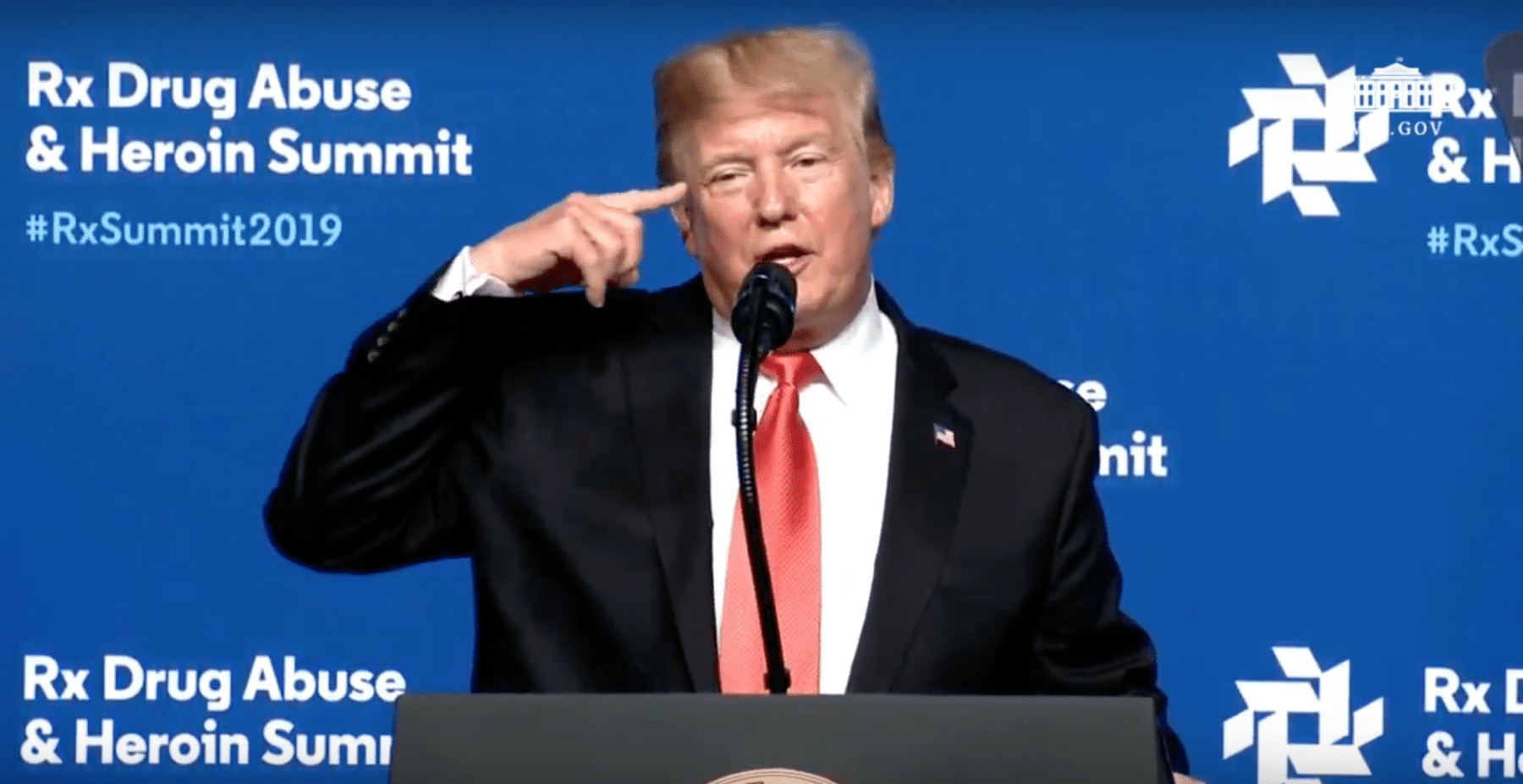President Donald Trump’s contradictory messages about his response to the opioid-involved overdose crisis were on full display during a self-congratulatory speech at the April 24 Rx Drug Abuse and Heroin Summit in Atlanta. Trump boasted about recovery funding pushed by his administration—yet from beginning to end, he underscored an imperative to continue a forceful, punitive approach.
At the self-described “Largest Annual Conference Addressing the Opioid Crisis,” Trump used his address to highlight his presidency’s accomplishments, ranging from low unemployment rates to criminal justice reform, with the First Step Act—all through the lens of the crisis. He noted his “strong support for faith-based initiatives,” like Tennessee’s Faith-Based Recovery Network. He also praised his administration’s efforts to boost funding for treatment programs with the Support for Patients and Communities Act as “historic”—although the actual budgetary significance of the law remains questionable.
What is indeed historic is that, under the guise of preventing opioid-involved overdoses, Trump encourages cruel punishments for people who distribute drugs, and systematically attacks people migrating to the US from Central America.
Trump’s drug policies shamelessly tout the transparently prohibitionist goal of a “drug-free” America. From boosting funding to the Drug-Free Communities program to regularly dropping the phrase on Twitter, Trump has emphasized his administration’s focus on abstinence-only prevention education.
“We know one of the most important ways to ending the opioid crisis is preventing young people from ever using drugs in the first place,” said Trump at the summit. His statement ignores all the evidence that many people use drugs even if you tell them not to, and research that shows the efficacy of harm reduction measures from safe consumption spaces to syringe programs and MAT. “Our massive public awareness campaign about the horrific suffering that drugs inflicts has already reached 58 percent of young Americans,” Trump claimed.
“If you do it properly, young people looking at these ads, they won’t start … And that’s one of the most important things we can be doing …When they look out and somebody comes to them and wants to sell them drugs, and they start thinking about what they just saw on television … it’s gonna be a little harder making that sale. And that’s okay with me.”
Trump doesn’t simply want to make drug transactions “harder” to complete. Rather, he echoed his past comments that using the death penalty for people who sell drugs would yield “incredible” results.
In his address, Trump lauded his trade dealings with Chinese President Xi Jinping, and particularly the diplomatic arm-wrestling he did to encourage the Chinese government to crackdown on fentanyl. “They’re going to make it a major crime. It’s not a crime now. It’s down as an industrial drug. They’re going to charge them with the highest level of crime. In China, unlike in our country, the highest level of crime is very very high. It’s the ultimate, you pay the ultimate price,” Trump grinned, in reference to untold numbers of executions for drug-law violations in China. “So I appreciate that very much.”
…..considered to be the worst and most dangerous, addictive and deadly substance of them all. Last year over 77,000 people died from Fentanyl. If China cracks down on this “horror drug,” using the Death Penalty for distributors and pushers, the results will be incredible!
— Donald J. Trump (@realDonaldTrump) December 5, 2018
The address wouldn’t have been a real Trump speech if he hadn’t emphasized his presidency’s cornerstone, fascistic border policy and the construction of The Wall.
“We are detaining, capturing—call it anything you want— more people than ever before … Some of those people are not people we want in our country,” Trump said, referring to the hundreds of thousands of Central American migrants, many of whom are fleeing violent conditions in part created by years of America’s export of the War on Drugs.
According to a recent report from the Guardian, some detention facilities along the Southern Border have thousands of available beds in the last week, which challenges the narrative that Immigration and Custom Enforcement is struggling to find more space to detain people seeking entry into the United States.
“Border control has been incredible,” claimed Trump. “A lot of drugs is being gotten by us. We are stopping the drug flow.”
“Soon we are going to have a wall, that’s going to be a very powerful wall,” he beamed. “That will have a tremendous impact on drugs coming into this country.” But transnational criminal organizations most commonly traffic drugs into the US through vehicles entering by way of official land ports, according to a November 2018 Drug Enforcement Administration (DEA) report. In particular, the DEA found that seizures of fentanyl—one of the key rallying points for Trump’s border policy—overwhelmingly occur at ports of entry or United States Border Patrol checkpoints.
Throughout the speech, Trump platformed law enforcement officials, like a Virginia state trooper who lost his son to an opioid-involved overdose and two Customs and Border Patrol officers.
“We love our law enforcement,” said Trump. “People are loving their law enforcement more than ever before, because we respect you, at the highest level, we respect you. The job you do is incredible. And dangerous! But it’s incredible.”
Trump never straightforwardly reassured the audience that he wanted to end preventable deaths. Instead he concluded his address with a prohibitionist mantra.
“As one united nation, we will work, and we will pray, and we will fight for the day when every family across our land can live in a drug-free America.”
Screenshot: The White House via Youtube





Show Comments